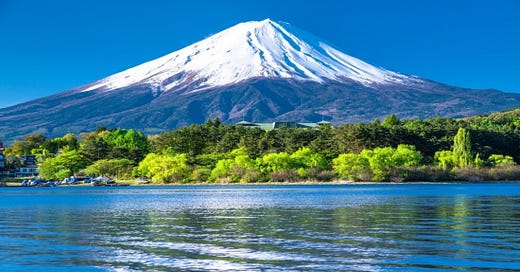November 6, 2024 – For the first time in 130 years, Japan’s Mt. Fuji had no snow on its peaks by November. The first sprinkles on the 12,300-foot mountain usually arrive in early October. The average October temperature has been 28.4 degrees Fahrenheit, considerably lower than 2024’s 34.9 degrees, a record high.
According to the European climate service, Copernicus, January of this year broke another heat record for planet Earth, 0.16 degrees warmer than January, 2024. Some scientists (identities not stated in article) reportedly claimed these numbers are the “warmest in about 120,000 years or since the start of human civilization.”
Meanwhile, 2023 was the hottest year on record - until 2024 beat it. Two days in July were the hottest on record since 1940. Greenhouse emissions from burning fossil fuels continue to heat up the planet. Sea surface temperatures marked the second highest in July.
This week’s news is enough to make you sweat: Earth’s ten hottest years have been the last ten years. The New York Times was positively apocalyptic, claiming that climate change is responsible for “drought, storms and wildfires (that) displaced hundreds of thousands of people…” Additionally, “methane and nitrous oxide [have} reached levels unseen in 800,000 years.”
According to VOX, “month after record breaking month, the Earth is heating up around us.”
Global warming is real. The numbers confirm it. Not so certain are the causes, along with this vital question: is the warming trend a natural fluctuation or a direct result of human activity?
This online summary attributes climate change to…
both natural and human activity. Cyclical lows in solar radiation, heightened volcanic activity, changes in the ocean circulation, variations in earth’s orbit and axial tilt (orbital forcing), inherent variability in global climate, and decreases in the human population (such as from the massacres of Genghis Kahn, Black Death, and epidemics emerging in the America’s upon European contract.)
Genghis Kahn was a nasty guy, but I didn’t know he was responsible global warming.
Earth’s temperature fluctuations are part of the natural order of things; like forest fires, it’s going to happen, human beings notwithstanding.
THE LITTLE ICE AGE
I recall seeing many oil paintings of the Dutch ice skating on frozen lakes hundreds of years ago. That heritage continues today as Dutch ice skaters usually dominate at the Winter Olympics. The little ice age was a period of regional cooling, mostly in the North Atlantic region.
The cooling lasted from around 14th through 19th centuries. NASA reports three particularly cold periods – punctuated by intervals of warming, beginning in 1650, 1770 and 1850. When the Dutch ice skated on frozen lakes, colder weather was the norm. When they strapped on their ice skates during those warming periods, they must have wondered why the ice was a little slushy. They could not have known they were in the midst of a miniscule fluctuation, lost in the vastness of the current ice age.
How vast? The Little Ice Age provides some perspective on climate change, but a few centuries of fluctuating temperatures, does not provide a broad enough perspective. So, fasten your seat belts as we rewind millions of years for a better view.
Climate change is, well, glacial. The last of the five major ice ages started 2.6 million years ago,and is still going on! Each ice age has periods of glaciers covering the Earth and warmer periods when the ice retreats. Amazingly, Earth has undergone more than fifty periods of ice, with warmer interglacial periods.
Ice Ages don’t always have ice. We are, in this very moment, between glaciations in the current ice age. Estimates from multiple sources tell us that the nice weather we’ve been having for the last 17,000 years, might continue for tens of thousands of years more. It should be noted that heavy industry and carbon emissions were not responsible for the cycles of warming and cooling over the last 2.6 million years. We can reasonably assume that the current warming fluctuation enabled our primitive predecessors to crawl out of their caves to learn to throw spears at mammoths, to farm, build permanent structures and on to locomotives, anti-biotics, space stations and butter pecan ice cream.
All of human history, everything we know about homo erectus, dating back far into to pre-historic times, is a warming pause. Without global warming, we would still be living lives that are “solitary, poor, nasty, brutish and short.” And cold. As a matter of fact, all of the 5000 years of recorded human history, and 12,000 more years, are just one warming fluctuation in the most recent glaciation of the current Ice Age.
The ice will come again.
Thus, when we transient creatures experience small fluctuations in climate, we are not seeing the forest for the trees. If Mt. Fuji didn’t have snow last October, I wouldn’t start panicking.
Disclaimer! Fred Singer, an expert on global warming who has written many books on the subject, has my name; or do I have his name since he’s older? He died a few years ago.








But it's so useful for leveraging political power! Nice synopsis. A pretty good History Channel video on the ice ages at the link:
https://www.youtube.com/watch?v=fyZNYdZynb0
Another good read, Fred—and something that’s very important for the masses to understand. On second thought, I suspect your argument is a bit too logical for many to handle.
It seems to me that the ‘anthropocentric climate change’ theory is a symptom of humanity’s 21st century mentality, wherein we believe that, because of our technological superiority, we have suddenly transcended and superseded all that has come before us.